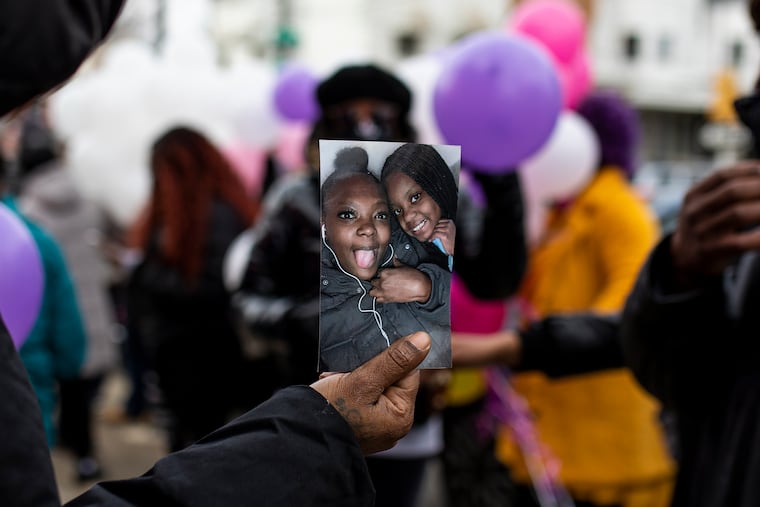The tragic loss of Nyssa Davis: A pediatrician’s call for safe firearm storage | Expert Opinion
Safe storage can dramatically reduce unintentional death and suicide in children.

Last week Nyssa Davis, age 9, was shot and killed inside her home in North Philadelphia. She was alone with her 5-year-old cousin, who reportedly pulled the trigger, and her 12-year-old brother, who has been arrested in connection with her death. The heartbreak of these families, and the suffering of these two boys, is impossible to imagine.
As pediatricians, we bear witness to the devastating impact of firearm death and injury on children and families. When our patients are shot, we care for their parents and siblings in the aftermath. We see them crushed by the weight of the loss, and we recognize the pain as it persists and washes down through the next generations. We see the way trauma ripples outward as well, the way entire communities are stunned and shaken by the senseless loss of one of their own.
This is why we are gravely concerned when our patients have access to firearms. We are doing our best to keep children safe, but we cannot do it alone. We need the weight of policies and laws behind us.
» READ MORE: A 12-year-old boy is arrested in the shooting death of his 9-year-old sister in North Philadelphia
Gun sales have gone through the roof during the COVID-19 pandemic. Data from FBI background checks indicate that almost 40 million firearms were purchased across the United States in 2020. This is higher than any number on record for a single year. In Pennsylvania we’ve seen 400,000 background checks in the last three months — almost double the number from the same time last year. Even before this surge, one third of U.S. households with children contained at least one firearm, and 4.6 million children lived in a home with a loaded, unlocked weapon.
We cannot overstate the risk this poses to our young patients.
Studies show that children know where guns are stored inside homes, that they cannot tell the difference between a real and pretend firearm, and that at as young as 3 years old, they are strong enough to pull the trigger. The majority of firearm deaths in children under 10 occur because a child was playing with a gun.
Suicide fatalities, too, are far greater when guns are present inside homes. If a child becomes suicidal, easy access to a lethal weapon can mean the difference between life and death. Over half of teen suicides are completed by firearm, and the majority of these weapons belong to a family member. Just last week I asked a teenager with suicidal ideation if she had a plan for taking her life. She told me she did — that she had found a gun on a shelf inside her home.
Our goal is the health and safety of every child we care for. This is why the American Academy of Pediatrics encourages us to talk about firearm safety the way we talk about car seats, bike helmets, and smoke detectors. We counsel families that the safest home is one without guns. And for those who are unable or unwilling to remove firearms from their homes, we meet them where they are. We know that they, like us, want nothing more than to keep their children safe. So we join firearm safety experts in recommending safe storage.
Storing firearms safely means keeping them locked, unloaded, and separate from ammunition. Safe storage can dramatically reduce unintentional death and suicide in children. While some health-care providers worry that patients won’t feel comfortable discussing firearm safety — that they may feel stigmatized or intruded upon — studies show most patients are open to having this conversation with providers they trust.
We know we can have the greatest impact by also offering safety devices at the point of care. At Children’s Hospital of Philadelphia, where I practice, we distribute cable locks to at-risk patients in our emergency department and have recently begun offering them in our primary care settings as well, with hopes for expansion across our network.
» READ MORE: Classmates, friends release balloons for 9-year-old gun victim Nyssa Davis | Video
As health-care providers we are doing everything we can. But our young patients would be safer if there were laws — as there are for car seats and bike helmets — reinforcing our recommendations. A recent landmark study shows states with stringent child access prevention (CAP) laws have 59% fewer firearm fatalities in children under 15 years old. Twenty states have laws in place to prevent children from accessing firearms. Pennsylvania is not one of them.
To be sure, safe storage legislation alone cannot entirely solve this problem. But we need all the help we can get. We need Harrisburg to enact child access prevention laws — or to redact the state preemption that prevents cities like Philadelphia from passing and enforcing our own — so families like Nyssa’s will never have to endure this kind of pain.
Imagine Nyssa at home with her brother and cousin, finding the gun. Now imagine the gun is locked and unloaded. No one is able to fire a shot. They finish their game and move on to play something else.
Maybe we can’t keep guns out of every house where our patients spend time. But we can at least keep our patients from using them.
Dorothy R. Novick is an attending physician at Children’s Hospital of Philadelphia (CHOP) and a Scholar with CHOP’s Center for Violence Prevention.